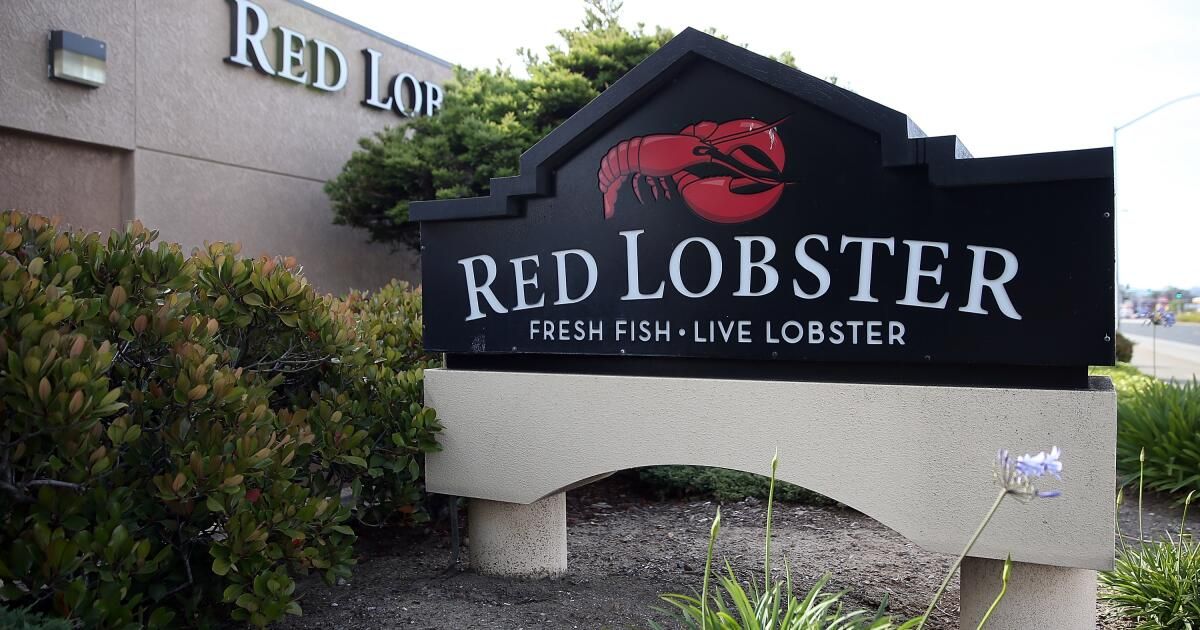At first glance, the story of Red Lobster's bankruptcy is about one of the seven deadly sins: gluttony.
The most striking manifestation of that sin, as my colleague Marisa Gerber reported, was the chain's experience with its $20 all-you-can-eat shrimp promotion, which attracted families who would park at restaurants for hours at a time, consuming mass quantities.
But that doesn't take into account the gluttony of Red Lobster's former private equity owners, San Francisco-based Golden Gate Capital, or its later corporate owners, the massive Bangkok-based seafood conglomerate Thai Union.
Red Lobster's real estate sale leaves its new owners little room for error.
— Restaurant analyst Jonathan Maze (2014)
According to Sunday's bankruptcy filing by the chain's new management, the chain was saddled with suffocating leases at “above-market” rents; These were the product of a financing agreement entered into by Golden Gate. Thai Union, the document implies, pressured the company to accept “burdensome supply obligations” that had little to do with the restaurants' actual needs.
Golden Gate declined to comment. A Thai Union spokesperson told me via email that the allegations contained in the filing are “baseless” and that he intends to continue his 30-year relationship with Red Lobster as a supplier.
That suggests Thai Union sees more profit selling shrimp to the chain than it does as a shareholder.
Newsletter
Get the latest from Michael Hiltzik
Commentary on economics and more than one Pulitzer Prize winner.
You may occasionally receive promotional content from the Los Angeles Times.
Put all this together and it becomes clear that one of the main causes of Red Lobster's financial collapse was the machinations of its owners.
In fact, the chain was traded several times between owners looking for a big reward; When their expectations were disappointed, they sold it.
As the bankruptcy filing put it, the chain “has transitioned from a privately held company to part of a publicly traded organization and then back to being private.”
It was founded as a single restaurant in Orlando in 1968 by Bill Darden, later acquired by General Mills, which then spun off Red Lobster along with its Olive Garden chain as Darden Restaurants. Darden sold Red Lobster in 2014 to Golden Gate, which sold it in stages to Thai Union and abandoned ownership completely in August 2020.
Late last year, Thai Union, which had bought a minority stake in the chain for $575 million in 2016 and bought the remainder for an undisclosed sum as a member of an investment consortium in 2020, wrote down its stake in Red Lobster to zero, assuming a charge of 527 million dollars.
Throughout that period, Red Lobster faced a number of challenges. Having made its mark nationally in the 1980s and 1990s as America's first “casual restaurant” chain (a step up from fast food but without premium-priced sit-down food), it now has around 550 company-owned locations in the United States.
(The bankruptcy filing says that Red Lobster's “rich history…spans seven decades,” but its arithmetic is wrong: It has only been around for 56 years.)
As time went by, American tastes changed and seafood-only restaurants fell out of favor. Then came the pandemic. According to the bankruptcy filing, restaurant diner numbers are still about 30% below their pre-pandemic level. Over the past year, its operating profits have fallen 60%. The chain lost $76 million in fiscal 2023.
As headwinds built, changes in Red Lobster's management were as dizzying as changes in ownership. From 2021 to now, the company has had four CEOs, including one who lasted eight months in 2021-22.
After that, the company was without a CEO for 17 months; The new incumbent took over last September and was succeeded in March by Jonathan Tibus, a turnaround specialist who is now in charge. Each new CEO arrived with new strategic ideas before giving way to a successor who attempted to undo the previous strategy and impose a new one.
However, if one is looking for the original sin in Red Lobster's decline, a good candidate would be the deal that put it under ownership of Golden Gate Capital. The private equity firm bought the chain from Darden for $2.1 billion, financing the sale in part by selling the real estate underlying 500 restaurants to real estate firm American Realty Capital for $1.5 billion.
This was a sale-leaseback transaction, in which Red Lobster instantly went from being the owner of its property to a tenant of the same property. Leases were typically long-term (up to 25 years) with annual rent increases of 2%. They were also triple net leases, meaning the restaurants were responsible for paying operating costs, property taxes and insurance.
Red Lobster thus lost a lot of flexibility to close underperforming restaurants and cut costs. The bankruptcy filing says a significant portion of the leases charge above-market rates. Of the company's $190.5 million in lease obligations last year, more than $64 million was for “underperforming stores.”
This exacerbated the company's financial problems. “Given the Company's operational headwinds and financial condition,” the filing says, “the payment of lease obligations associated with delinquent leases has caused significant strains on the Company's liquidity.” In other words, the sale-leaseback deal was draining cash from the company.
The sale and lease deal attracted attention among restaurant analysts at the time. “Let's get this straight,” wrote Restaurant Finance Monitor's Jonathan Maze: “We're taking a brand with sharply declining sales and profits, and then loading it up with rental costs?”
At first, Red Lobster would pay $118.5 million in rent in cash, about half of the chain's annual operating profits, he wrote. “Red Lobster's real estate sale leaves its new owners little room for error,” she added presciently. Golden Gate declined to comment.
It's appropriate to note that this type of transaction resembles private equity deals that have been blamed for the deterioration of consumer businesses in other industries. Private equity takeovers often result in large-scale layoffs of workers and the imposition of heavy debt on companies that can accelerate their decline, in addition to generating higher costs for consumers.
The pattern was for private equity funds to “buy controlling stakes in companies for a short period of time, then load them with debt, strip them of their assets, charge them exorbitant fees, and sell them at a profit, implementing drastic reduction measures.” costs at a reasonable price.” at the expense of workers, consumers, communities and taxpayers,” Democratic lawmakers wrote in 2019.
Purchases of private, for-profit colleges, for example, led to higher tuition charges and higher student loan balances among students, according to a 2019 study of several such deals; these were accompanied by “sharp declines in student graduation rates, loan repayment rates, and labor market earnings.”
And local newsrooms across the country have been destroyed by the private equity firm Alden Global Capital, which has become famous for its aggressive cost-cutting and disregard for the quality of the resulting products; By the beginning of this decade, Alden owned about 200 newspapers, including the Chicago Tribune, the Baltimore Sun and the San Diego Union-Tribune.
When Golden Gate sold its stake in the chain, the restaurants were saddled with a heavy debt load; About $375 million in debt was added to the chain's balance sheet in May 2014 to help finance the Golden Gate acquisition, Moody's reported. The debt matured in 2021.
That brings us to the Thai Union. Thai Union, one of the world's largest fishing companies, owns Chicken of the Sea tuna, among other holdings. Its involvement in the canned tuna business got it into trouble in 2018, when the federal government alleged a price-fixing conspiracy involving Chicken of the Sea, Bumble Bee and StarKist.
The government discovered the deal when it subjected a proposed merger between Chicken of the Sea and Bumble Bee to antitrust scrutiny. As I wrote at the time, Thai Union “quickly bailed out of the merger and confessed to the Department of Justice in exchange for an amnesty from prosecution.”
Thai Union originally bought Red Lobster as a strategic foray into restaurant retail. According to the bankruptcy filing, Thai Union eventually pressured the restaurant chain to increase its demand for shrimp, a Thai Union product.
One result was the conversion of the chain's “Ultimate Endless Shrimp” offer, which had been an occasional limited-time promotion, into a permanent menu item. The filing says that was done, despite “significant pushback” from members of the management team, at the urging of Paul Kenny, who had been appointed interim interim CEO in April 2022 “under the direction of Thai Union.”
Current management says Thai Union “exercised enormous influence on the company's shrimp purchasing,” bypassing the chain's “traditional supply process” and ignoring its demand projections. It says Kenny took steps to eliminate two breaded shrimp suppliers, giving Thai Union “an exclusive deal that led to higher costs for Red Lobster.”
Current management says it is “investigating the circumstances surrounding these decisions.”
The bottom line is that it's not unreasonable to blame some of Red Lobster's problems on its endless shrimp promotion, but it's more important to examine how that promotion came about in the first place.
The answer, according to the management team charged with getting the company out of its financial quagmire, is that it was imposed by interested owners.
One had no experience running a restaurant chain, didn't notice the signs that it was heading toward a fiasco, and may not have cared as long as he could keep pumping shrimp into the chain's pipeline. The other collected a healthy subsidy for his multimillion-dollar acquisition, and perhaps didn't realize or care that he was tying one hand behind the chain's management as it faced a sea change in consumer habits.
Red Lobster became a toy for financial engineers, a condition that rarely – if ever – leads to a better consumer experience and higher long-term profits. It's one thing to blame Red Lobster's problems on consumers who eat shrimp, but who were the real pigs in this saga?












